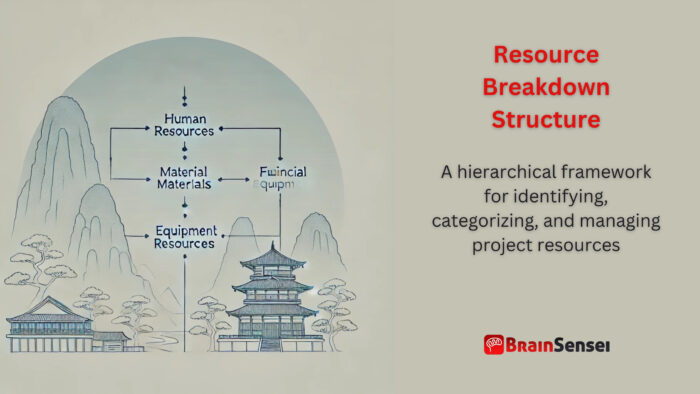
Resource Breakdown Structure
What is Resource Breakdown Structure?
A resource breakdown structure (RBS) is a hierarchical framework for identifying, categorizing, and managing project resources. It provides a detailed view of all human, material, equipment, and financial resources essential for project execution. Project managers can streamline allocation, track resource usage, and improve cost control by organizing resources systematically.
Key Takeaways
- A Resource Breakdown Structure categorizes resources hierarchically
- It enhances resource allocation, monitoring, and cost management
- The RBS includes human, material, equipment, and financial resources
- It aids communication among stakeholders regarding resource utilization
- A well-structured RBS supports more accurate project planning and forecasting
Understanding the Resource Breakdown Structure
How It Works
The RBS typically starts with high-level resource categories, such as personnel, materials, equipment, and costs, and then breaks down each category into more specific components. For example, the project manager may subdivide the personnel category by department, role, or skill set.
Project managers use the RBS to create a resource management plan, ensuring that the right resources are available when needed. The plan also helps with risk management by identifying potential resource constraints early in the project lifecycle.
Notes
- Ensure clarity and consistency when categorizing resources
- Align the RBS with the project’s Work Breakdown Structure (WBS)
- Regularly update the RBS to reflect changes in resource availability
- Use software tools to automate RBS creation and monitoring
- Involve key stakeholders in developing the RBS for better resource estimation
Related Terms
- Work Breakdown Structure (WBS): A hierarchical decomposition of project work into smaller, manageable components.
- Organizational Breakdown Structure (OBS): A structure that illustrates project tasks and responsibilities across organizational units.
- Cost Breakdown Structure (CBS): A detailed breakdown of project costs by categories and subcategories.
- Resource Allocation Matrix (RAM): A chart that assigns resources to specific tasks.
- Project Resource Plan: A document outlining the resources needed, their availability, and their management strategies.
Examples of Resource Breakdown Structure in Various Industries
Manufacturing Industry
An RBS might categorize resources into labour, machinery, materials, and overhead costs for a manufacturing project. For instance, a project manager could divide labour into production staff, maintenance technicians, and quality inspectors. This structure helps ensure that critical resources like specialized equipment operators are available to avoid production delays.
Moreover, the RBS supports better forecasting and planning. By identifying specific labour requirements, the company can plan for training programs or recruitment efforts in advance. Additionally, tracking materials through the RBS helps maintain optimal inventory levels and reduces costs associated with excess stock or last-minute procurement.
For example, a car manufacturing plant in Detroit used an RBS to manage the assembly line. The RBS detailed labour requirements by production stage, helping HR plan shifts effectively. It also tracked materials like steel and rubber, which helped procurement teams negotiate better deals with suppliers.
Healthcare Industry
An RBS might manage resources like medical equipment, construction materials, and healthcare personnel in a hospital renovation project. The medical equipment category could include MRI machines, ventilators, and surgical instruments, with each item tracked for procurement and installation schedules.
In addition, the RBS aids in regulatory compliance by documenting the use and maintenance of critical medical devices. Project managers can generate reports to demonstrate compliance with healthcare standards. The structure also supports budgeting by clearly associating costs with resource categories.
For instance, a hospital in New York used an RBS during its emergency room expansion. The RBS identified equipment shortages early, allowing the hospital to secure necessary devices before they impacted the construction timeline.
Government Sector
The RBS could classify resources into administrative personnel, contractors, raw materials, and financial allocations for a public infrastructure project. Within the economic category, subcategories include federal grants, state funds, and contingency reserves to ensure budget transparency and compliance.
The RBS also facilitates stakeholder communication by presenting a clear resource overview. In a city bridge construction project in California, the RBS highlighted the need for additional surveyors, which prompted the city council to approve a budget increase early in the project. This proactive approach helped avoid costly delays.
Furthermore, the structure helps monitor performance by linking resource usage to project milestones. Project managers can compare actual consumption against estimates to identify areas for improvement in future projects.
Use Cases of Resource Breakdown Structure Across Regions
United States (Construction Project)
A large construction firm in Texas utilized an RBS to manage a high-rise building project. The structure included categories like human resources (engineers, architects, labourers), materials (concrete, steel, glass), and equipment (cranes, bulldozers). The RBS enabled the project team to track resource usage efficiently, reducing delays and cost overruns.
The project team also used the RBS to improve communication. By presenting resource information visually, stakeholders quickly understood the allocation plan. This transparency fostered better collaboration between the construction and procurement teams.
Moreover, the RBS helped identify potential shortages. When the company noticed a shortfall in crane operators, it arranged training for existing staff and expedited the hiring process. This proactive approach ensured that construction proceeded without significant interruptions.
Europe (Automotive Industry)
An automotive manufacturer in Germany implemented an RBS to streamline its electric vehicle production line. The structure helped categorize resources like battery components, assembly robots, and production staff. As a result, the company optimized resource allocation and minimized production bottlenecks.
The company integrated the RBS into the enterprise resource planning (ERP) system. This integration allowed real-time tracking of component deliveries, ensuring a consistent supply of materials for assembly lines.
In addition, the RBS revealed a gap in technician availability for robot maintenance. The company created a training program, ensuring sufficient skilled personnel were available to maintain production efficiency.
Asia (IT Infrastructure Upgrade)
A telecommunications company in Japan adopted an RBS for a nationwide 5G network rollout. The project manager categorized the resources into hardware (antennas, routers), software (network management tools), and personnel (engineers, technicians). This systematic approach facilitated efficient resource allocation across multiple project phases.
The project team regularly reviewed the RBS to address changing requirements. For instance, when demand for routers unexpectedly increased, the RBS helped the procurement team swiftly secure additional units.
Additionally, the RBS supported risk management. By tracking resource dependencies, the company identified potential delays early and adjusted schedules to mitigate these risks.
Best Practices of Resource Breakdown Structure Implementation
Implementing an RBS requires careful planning and attention to detail. Here are some best practices:
Align with Project Goals
Ensure the RBS reflects the objectives and deliverables.
Involve Stakeholders
Engage project stakeholders to improve resource estimation accuracy.
Use Project Management Software
Leverage tools like MS Project, Primavera, or Asana for RBS development.
Maintain Flexibility
Update the RBS as project requirements evolve.
Integrate with WBS
Coordinate the RBS with the Work Breakdown Structure for comprehensive project planning.
In addition, a successful RBS implementation includes regular training sessions for project managers and resource coordinators. Training ensures that all team members understand how to use the RBS effectively.
For instance, the team implemented a detailed RBS in a large-scale IT project to manage hardware, software, and personnel resources. Regular RBS reviews helped the team identify underutilized servers reallocated to more critical applications, optimizing performance and reducing costs.
Ignoring these practices can lead to resource shortages, scheduling conflicts, and increased costs. Continuous improvement, driven by lessons learned from past projects, further enhances RBS’s effectiveness.
Common Mistakes and Issues
Failing to Update the RBS
One common mistake is failing to update the RBS as the project progresses. For instance, a construction company in Florida faced delays because it overlooked changes in material availability. The RBS listed a specific type of steel that later became scarce, delaying structural work by several weeks. Regularly reviewing and updating the RBS would have mitigated this issue.
Creating Generic Resource Categories
Another issue arises from creating overly generic resource categories. When resources are not defined precisely, teams may struggle to allocate and track them effectively. For example, labelling all technical staff as “IT personnel” might obscure the need for specialized skills like cybersecurity or software development.
Failing to Engage Stakeholders Fully
Additionally, insufficient stakeholder involvement during RBS development can result in inaccurate resource estimates. Project managers should engage department heads, procurement teams, and other relevant stakeholders early to gather comprehensive resource requirements.
Lacking RBS Clarity
A lack of clarity in the RBS led to procurement delays in a global software project. The team failed to distinguish between regional and international resources, resulting in duplicated orders and budget overruns. Clear, detailed categorization could have prevented this issue.
Ignoring RBS Integration
Furthermore, ignoring the integration of the RBS with other project management tools can hinder its effectiveness. The RBS should align with the WBS, cost breakdown structure, and project schedules to provide a holistic view of resource needs.
Updating Training and Documentation
Regular updates to training and documentation are essential to maintaining an accurate, valuable RBS. As team members change or project requirements evolve, updated guidelines help ensure consistency.
Frequently Asked Questions (FAQs)
Why is a Resource Breakdown Structure important?
An RBS provides a clear overview of project resources, aiding in efficient allocation, cost control, and risk management.
How does RBS differ from WBS?
While the WBS focuses on tasks and deliverables, the RBS categorizes and tracks resources required to complete those tasks.
What tools are commonly used to create an RBS?
Popular tools include MS Project, Primavera P6, and cloud-based platforms like Asana and Monday.com.
Can an RBS be applied to small projects?
Even small projects benefit from an RBS by clarifying resource needs and availability.
How often should the RBS be updated?
Project managers should regularly review and update the RBS, mainly when the scope, resources, or timelines change.
Additional Resources
- Aspects of a Work Breakdown Structure (WBS)
- What Are The 4 WBS Levels and The Relationship Between Them
- Work Breakdown Structure
Preparing for a PMI certification?
- Exam Prep Courses: PMP®, CAPM®, and PMI-ACP®
- Exam Simulators: PMP®, CAPM®, PMI-ACP®, PMI-PBA®, PMI-RMP®, PMI-SP®, PgMP®, and PfMP®
- Professional Development Units (PDUs): 15, 30, and 60 PDU Bundles



